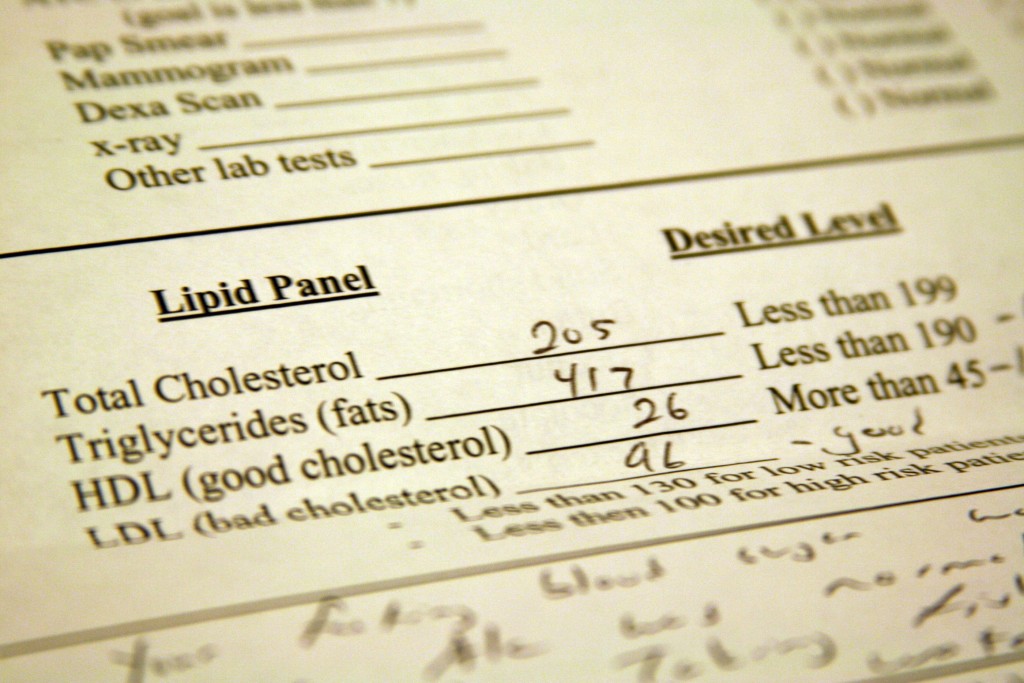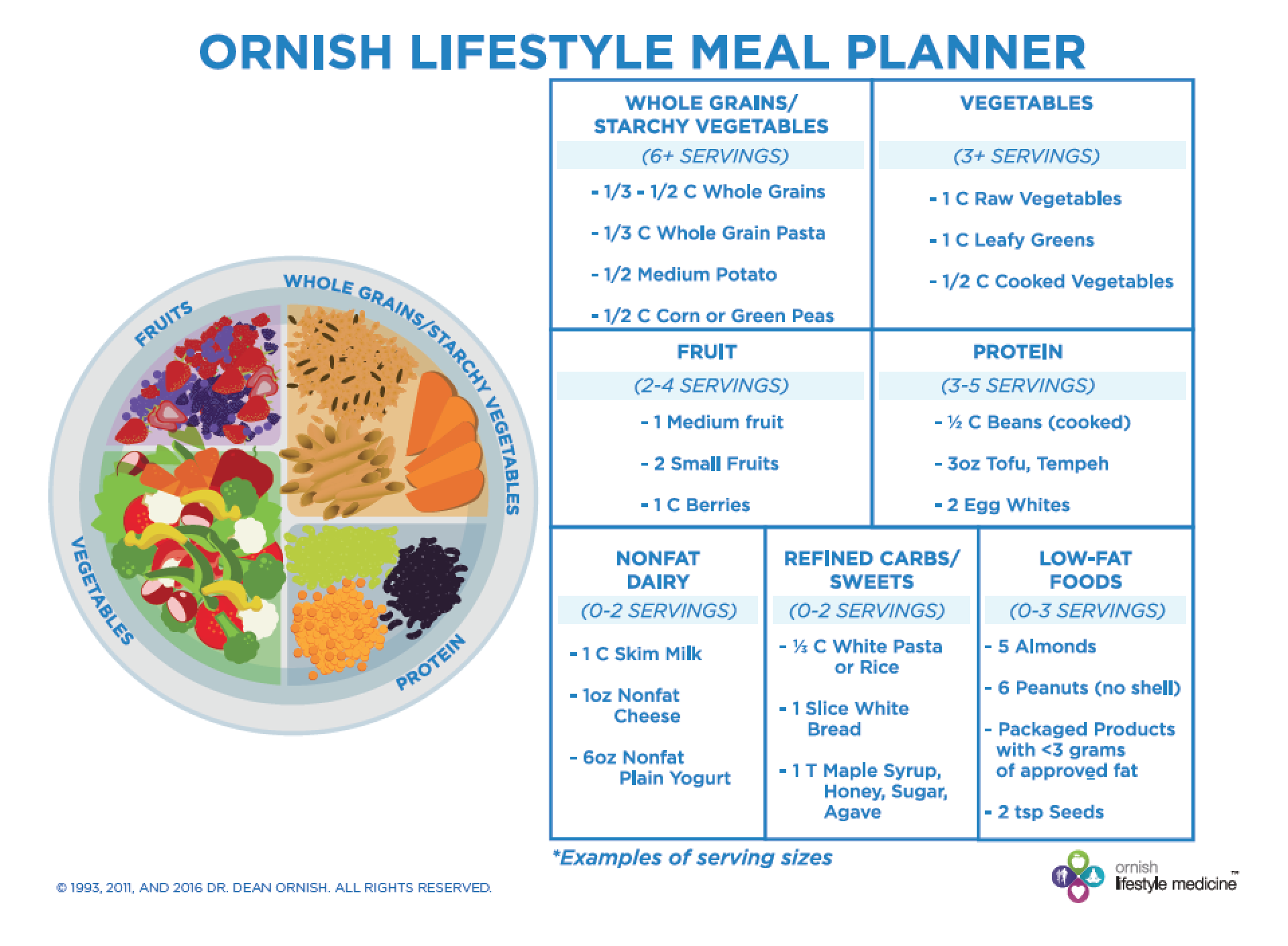
How to Optimize Your Triglycerides Levels
Both genetics and lifestyle play an important role in our risk of heart disease, including our predisposition for elevated triglycerides. Familial hypertriglyceridemia, which occurs in about 1 in 500 people in the United States, is a genetic condition that causes the triglyceride levels in the blood to get too high.
When you eat more than you need, your body makes excess triglycerides
The best way to lay a good foundation for managing blood lipids, as well as other underlying risk factors that contribute to high triglycerides and heart health, is a plant-based lifestyle. This includes eating whole foods that are high in fiber and phytonutrients, rich in omega-3 fatty acids, and have a low-glycemic impact. ʺIn addition to diet, it’s also important to maintain an appropriate weight, exercise daily, manage your stress levels, and ensure quality sleep and love and support, which are all pillars of the Ornish Lifestyle Medicine (Intensive Cardiac Rehabilitation).
What are Triglycerides?
Triglycerides are the main type of blood fats and are distributed to tissues for energy or stored as fat in the body. Your body then uses the stored energy as fuel. Triglycerides are the primary fat in meat, dairy, margarine, and oils, which is why our blood triglyceride levels rise after we eat those foods.
Consuming excess calories and food high in sugars, simple carbohydrates and alcohol can also have a significant impact on triglycerides levels. This is because when you eat excess simple carbohydrates such as white pasta, rice and bread, and high sugar desserts and beverages, your blood sugar (glucose) spikes, and your insulin rises in response. When your body has more glucose than it needs for energy and has reached its storage capacities in the liver as glycogen, the glucose is converted into triglycerides, which are then stored as fat. When you eat more than you need, your body makes excess triglycerides.
High fiber complex carbohydrates from whole grains, fruits and starchy vegetables do not have the same impact due to the influence of the protective fiber that slows down the release of sugars from the carbohydrates. Studies have shown that a high fiber diet protects against carbohydrate-induced hypertriglyceridemia.
Ornish Lifestyle Medicine is an excellent example of how a moderate to higher complex carbohydrate plant-based approach can improve heart health and reverse heart disease.
High Triglycerides and Heart Health
Evidence suggests that elevated triglyceride levels are an independent risk factor for heart disease; however, this risk factor is still not clearly understood and is often accompanied by other factors. Lifestyle factors that contribute to elevated triglycerides include being overweight or obese, consuming too much fat, refined carbohydrates, or alcohol. Certain conditions such as diabetes, kidney disease or thyroid issues can effect triglyceride levels. Steroids, some blood pressure medications (i.e. thiazide diuretics and beta-blockers), acne medicines or hormones such as testosterone, estrogen or oral contraceptives can also increase triglycerides.
Get to the Root Cause
Understanding why triglycerides are high is the real key to managing your heart health. For example, high triglycerides can be an indirect measure of insulin resistance. Insulin resistance is a condition in which you develop a tolerance to insulin and the body does not use it very well. As a result, blood sugars also tend to rise because the glucose can’t get into the cells. This can lead to pre-diabetes of Type 2 diabetes.
The Connection Between High Triglycerides and Metabolic Syndrome
Insulin resistance is the driving factor behind Metabolic Syndrome, which is characterized by having at least 3 of the following marker.
- Overweight/obesity, elevated waist circumference (i.e. abdominal obesity)
- Elevated triglycerides
- Low HDL
- High blood pressure
- Elevated fasting glucose (an indicator of insulin resistance). If your triglycerides are greater than 100 and your HDL-C is less than 50, or the ratio of triglycerides to HDL-C is greater than 4, then you have metabolic syndrome. Ask your physician to do a glucose insulin challenge test and test for insulin and glucose. Remember high, damaging insulin levels happen a long time before high glucose levels!
Abdominal obesity, blood sugar and insulin imbalances, high blood pressure and abnormal blood cholesterol levels influence each other (as well as other systems) and your risk of disease. Anything driving chronic inflammation contributes to insulin resistance (and vice versa). All of these underlying factors of disease are interconnected so, even if you only have 1 marker of metabolic syndrome, it’s worth correcting. Be aware of other risk factors as well since that may help to clue you into the root cause and help you optimize your triglycerides and overall heart health.
How Diet and Lifestyle Can Improve High Triglycerides and Metabolic Syndrome
When triglyceride levels are moderately elevated (70-250 mg/Dl) the priority is on improving LDL and HDL. However, when triglycerides are higher than 250 mg/Dl, it becomes necessary to approach the treatment of this risk factor more aggressively. Change in diet and lifestyle can have a strong influence on both triglyceride levels and metabolic syndrome or “pre-diabetes.”
Diet
We eat food, not nutrients so a focusing on your overall dietary pattern versus specific foods and/or nutrients is key.
A whole foods, plant–based that is:
High in phytonutrients: ʺThink of a rainbow of color; fill half your plate (see infographic above) with colorful produce (mostly non-starchy vegetables with a serving of fruit) and the other half of the plate with phytonutrient rich plant proteins such as legumes or soy foods and high fiber whole grains or colorful starchy vegetables like winter squash packed with cardio-protective phytonutrients.
High fiber: Choose fiber rich whole grains such as brown or wild rice, quinoa, oats, buckwheat or farro. This includes three or more daily servings of non-starchy vegetables such as broccoli, cauliflower, carrots, and dark leafy greens and two to four daily servings of whole fruits such as berries, apples or oranges.
Rich in soluble fiber: Soluble fiber is most closely linked to improved triglycerides, blood sugar and cholesterol management. Foods high in soluble fiber include certain whole grains such as oats, beans, lentils, and pectin-rich fruits such as berries, apples and peaches. Some vegetables are higher in soluble fiber such as broccoli and Brussels Sprouts.
Limited refined carbohydrates and a low-glycemic load: Glycemic index (GI) and glycemic load (GL) are both used to measure the impact a carbohydrate food has on blood sugars, insulin and potentially triglycerides levels. Foods that quickly raise blood glucose levels receive a higher glycemic index number than foods that raise blood glucose levels more slowly. However, GL is a better predictor of how a carbohydrate food will impact blood sugars because it takes into account the amount of carbohydrates. For example, the GI of watermelon is high (GI = 72), but its GL is relatively low (GL = 7), because the quantity of carbohydrate in a slice of watermelon is minimal, as it contains a lot of water.
Studies show that by substituting low-GI for high-GI foods in a low-fat, high- carbohydrate diet lower triglyceride 15% to 25%.
When fiber is added to the mix of higher glycemic index foods, it can reduce the glycemic load of the meal, improving blood sugar and triglyceride levels. This could include adding salad or a bowl of non- starchy vegetables to your plate.
Foods with low GL (≤ 15) include garbanzo, black, pinto, kidney, soy beans, lentils; high fiber vegetables such as leafy greens, tomatoes, cabbage, cauliflower, green beans, carrots; fruits such as apples, pears, grapefruit and watermelon; whole grains such as quinoa, brown rice, bulgur, and barley, and some whole grains cereals with 100% bran, or 100% whole grain breads such as whole wheat, pumpernickel and barely.
Adequate protein: Including a protein-rich source with each meal or snack is important for triglyceride management. Ornish Lifestyle Medicine recommends several small, frequent balanced meals and snacks throughout the day. Plant-based proteins include beans, lentils and soy foods such as tofu and tempeh. Egg whites and non-fat dairy sources such as non-fat plain Greek yogurt are allowed in limited amounts.
Avoid/limit alcohol: Since alcohol can increase triglycerides, avoiding or limiting alcohol to two drinks or less a week can support triglyceride management.
Omega-3s: Strong evidence supports the role of omega-3 fatty acids in reducing triglycerides. Plant based food rich in omega 3s include edamame and other soy foods such as tofu and tempeh, black and kidney beans, winter squash, and flaxseeds and walnuts in limited quantities.
Many clinical trials suggest doses of ≥ 2 grams/day of omega 3 from fish oil (eicosapentaenoic acid (EPA) plus docosahexaenoic acid (DHA) are needed to significantly lower triglycerides with optimal doses being 3-4 grams/day.)
When choosing supplements, it is important to choose a quality, professional line that has been third party tested for purity, oxidation (rancidity), heavy metals and/or other toxins, and, ideally, studied for efficacy and safety. Ornish Lifestyle Medicine recommends a cholesterol-free fish oil or plankton/algae based omega 3.
It is always essential to first discuss with your physician before adding or changing supplements.
Weight Management and Exercise
Lose weight if necessary; even a 10% weight loss can result in reductions in triglyceride levels.
Exercise has shown to increase HDL-C and result in modest reductions in triglyceride levels. An exercise routine should include both cardiovascular and resistance training. Interval training is supportive to address metabolic syndrome and unhealthy body composition (increased fat-to-muscle mass).
Sleep
Poor quality sleep can have major impacts on your health. Insufficient sleep, sleep deprivation, and misaligned sleep timing have been linked with metabolic syndrome, higher triglyceride levels, lower HDL levels, and other negative metabolic and behavioral effects. Sleep apnea, a condition in which a person stops breathing during night and for which there is a high prevalence in patients with cardiovascular disease, is a known risk factor for cardio-metabolic disease. (See Ornish Living article, How Regular Exercise Can Benefit Sleep (And Decrease the Symptoms of Sleep Apnea)).
Daily strategies to help manage stress and improve sleep include yoga, meditation, prayer, exercise, and a sense of community. Revise your sleep habits if necessary by dedicating enough time to sleeping and creating a sanctuary for sleep.
Stress Management
Physical and emotional stress contributes to increased risk of heart disease, metabolic syndrome and a host of other chronic health conditions. Daily stress management such as yoga or meditation is essential to managing these health conditions.
To reduce and manage your risk of heart disease you need to address high triglyceride levels as well as other risk factors such as metabolic syndrome, and that can be done effectively with a comprehensive diet and lifestyle approach.
What can you do today to optimize your triglycerides and overall heart health using diet and lifestyle?








